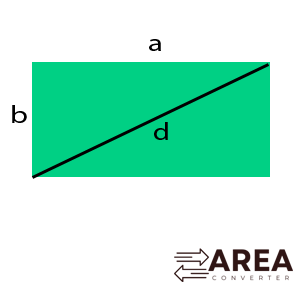Area rectangle calculator
If you're looking to calculate the area of a carpet, a plot of land, a TV screen, a rectangular pool, or even a window, this rectangle area calculator is here to provide quick and accurate results!
Simply enter the length and width, and let this tool effortlessly determine the area and diagonal for you.
Curious about the concept of a rectangle? Keep reading to explore its definition, key formulas, unique properties, and step-by-step guidance on calculating the area of a rectangle.

Rectangle calculator
Definition: What is a rectangle?
A rectangle is a two-dimensional geometric figure classified as a quadrilateral, characterized by four sides and four right angles (each measuring 90 degrees). Opposite sides of a rectangle are equal in length and parallel, making it a special type of parallelogram. The internal angles of a rectangle sum up to 360 degrees.
Mathematically, a rectangle's defining property is that the diagonals are equal in length and bisect each other. It is often studied in the context of Euclidean geometry and serves as a foundational shape in mathematics, engineering, and design due to its symmetry and straightforward properties.
How to calculate the area of a rectangle?
To find the area of a rectangle, you use the formula:
Example
If the length of a rectangle is 8 meters and the width is 3 meters, the area is:
A = 8 × 3 = 24 square meters (m²).
Important notes
- Unit consistency: Ensure both length and width are in the same units before performing the calculation.
- Real-world applications: This formula is widely used for practical purposes like determining the area of rooms, gardens, or plots of land.
- Rectangular properties: This method is specific to rectangles, as the opposite sides are parallel and of equal length.
By using this simple formula, you can calculate the area of any rectangle with ease.
How to calculate the diagonal of a rectangle?
To calculate the diagonal of a rectangle, you use the Pythagorean theorem, which relates the sides of a right triangle. The formula is:
Explanation
The diagonal of a rectangle forms the hypotenuse of a right triangle, with the rectangle's length and width serving as the other two sides. By squaring the length and width, adding them together, and taking the square root of the result, you determine the diagonal's length.
Example
If the length of a rectangle is 6 meters and the width is 8 meters, the diagonal is calculated as:
d = √(6² + 8²) = √(36 + 64) = √100 = 10 meters.
